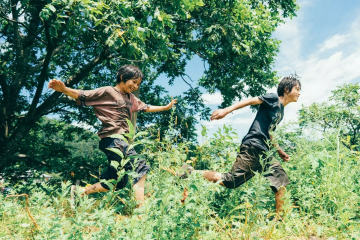C. J. ‘Fiery’ Obasi
(Released on 27/09/2023)
Watched at the Festival Cinémas d’Afrique de Lausanne 2023
Mami Wata is a modern African tale. A story in which the Sacred and the Profane are present at the same time, and the inherent clash between these contrasting forces is the cornerstone on which the film is built. But what is Mami Wata? Mami Wata, in the culture of West, Central, and Southern Africa is the goddess of water. She is believed to possess the power to bestow blessings, wealth, and fertility upon her devotees, but she also demands offerings and sacrifices. In essence, Mami Wata is the one who protects the village. This film is set in a fictional village, called Lyi, on the shores of the Ocean. Lyi is sealed off from the outside world by Mami Wata’s messenger, Mami Efe, who refuses to let modernity into the village. The village remains a mystical and supernatural place, still listening to and in contact with the land. For this, in complete opposition to the natural and modern world of the outside, where modernity is seen as the negative reason why people have stopped listening to nature. But Mami Efe must come to terms with reality and modernity, personified by her two daughters, Evelyn and Prisca. And it is precisely the latter that successfully synthesizes the union of the Sacred and the Profane. Prisca is the only one able to feel the importance of the supernatural and the necessity of the natural at the same time and tries to unite these two very different entities. In the village, too, there are those who need and those who question the supernatural. And, as in all myths, when the faithful doubt the god, when they are at their most distrustful point at the entrance of darkness, the god sends a final test to prove their faith. Jacob is the test that is sent to the inhabitants of Lyi, a soldier who arrives from the outside world transported from the sea to the village.
Mami Wata is certainly the most visually stunning film of the Festival Cinémas d’Afrique de Lausanne, and one of the most aesthetically pleasing films I have seen recently. The film is photographed in harsh black and white, where the play of contrasts is intensified to the utmost. When combined with the meticulously composed photography and the incorporation of traditional, and futuristic costumes and makeup techniques, makes watching Mami Wata an unparalleled and unique experience. Everything is taken care of down to the finest detail by director C. J. ‘Fiery’ Obasi. The photography is central to this story, so central that one often forgets to read the subtitles because transported by the image into darkness and light. Unfortunately, this aesthetic beauty remains merely visual, failing to blend with the story. It almost feels like watching two different films, the one being narrated and the one being pictured.
The strong visual contrast is not echoed in the narrative in which many of the themes established at the beginning are then forgotten. Mami Wata counterposes a children’s fairy tale with an all-too real African story. As the movie progresses it quietly leaves the fable plane to enter the real, leaves the supernatural to drift gradually into the natural. However, it abruptly reverts to the fairy tale plan in the finale to conclude an otherwise difficult conflict; perhaps a little too abruptly, leaving the viewer with a bitter taste in his mouth, watching an awaited and wanted ending, but not in this way…
- Mario Di Luca


